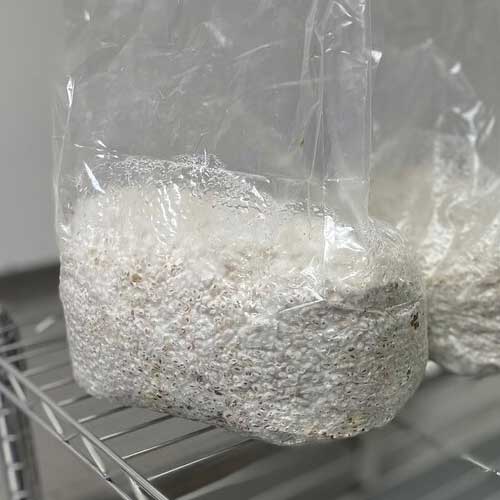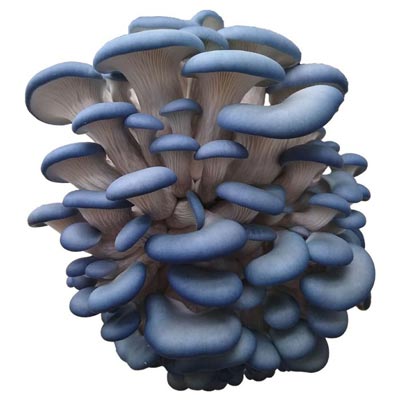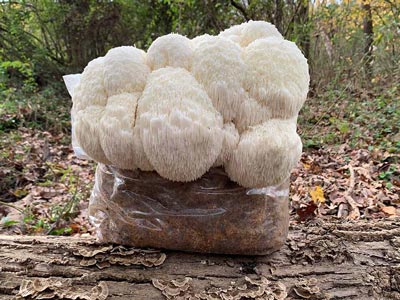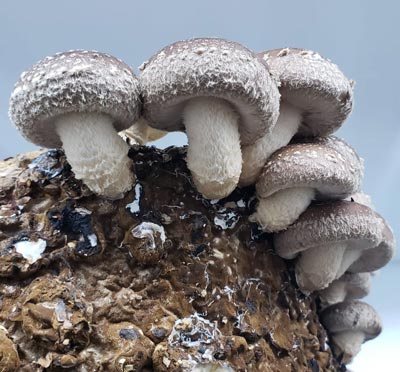Using Grain Spawn Packs
Using grain spawn – ready-colonised

Although many customers buying our colonised grain spawn packs will already be familiar with grain spawn and how to use it, we have also produced this simple ‘how to’ guide for those who are less sure of what to do.
Spawn Appearance
The photo here shows a block of fully colonised grain spawn, which in feel and appearance is a single white block of grain held together by a network of mycelium. We produce grain spawn in 3Kg or 5Kg blocks and then break them up, either for immediate use, or to divide them into 1Kg spawn bags for sale online.
When blocks like this are broken up, the visible mycelium mostly disappears because the mycelial network gets fragmented. Mycelium grows as a connected web of hyphae, and its density and visibility depend on its structural integrity. When the block is broken, these connections are disrupted, and the mycelium appears significantly less prominent, though it is still present on the individual grains.
This fragmentation is actually beneficial for propagation. Breaking up colonized grain increases the number of inoculation points, enabling faster colonization of new substrates. However, during this process, mycelium might temporarily seem less active or visible as it adjusts to the new environment and regrows its network.
Although fully colonised grain spawn is fairly contamination-resistant, users still need to follow sterile working and handling practices, unless your aim is to start your very own green mould farm! In particular, your substrates and the containers you plan to put the grain and substrate into need to be properly sterilised prior to use.
Other things you should know..
Colonised grain spawn
We produce colonised grain spawn for several mushroom types, both for our own use and also a local grower, so we choose to make small quantities of that available to online customers – always subject to availability. We use organic rye grain as the base for our grain spawn, but our colonised grain spawn bags will often contain a percentage of millet (or sometimes slices of agar) if this was how we initially inoculated the grain.
Inoculation
When we speak about inoculating grain we are referring to the process you might think of as ‘seeding’ the grain by adding an inoculate material such as liquid mycelium culture or pre-colonised millet or agar.
Colonisation
After live mycelium is added to a nutritious food source such as rye, millet or agar, it grows – or colonises – the grain or other substance. Eventually, the grain is bound together and covered healthy white live mycelium. This is called colonisation. As mentioned above, when a block of colonised grain spawn is broken up, the white mycelium seems to mostly vanish. This always happens when colonised grain is broken up and it’s perfectly normal! If you were to leave your grain spawn at incubation temperatures for a few days it would quickly start to go white again.
Using Colonised Grain Spawn
Important – Only Use Suitable Substrates!
We supply colonised grain spawn for several mushroom species, although availability of specific species may vary from time to time. Most of the colonised grain spawn we supply is for ‘wood-loving’ mushroom species, and for these, a hardwood-based substrate is required. Before buying grain spawn from us, or buying pre-made substrate, you are strongly advised to check precisely which substrates the specific type of mushroom you plan to grow requires. We have added a quick list of commonly used substrates at the bottom of this page.

Grey/Blue Oyster Mushrooms
Blue Oyster Mushrooms
Oyster Mushrooms are among the easiest of mushrooms to grow at home. Blue Oysters are particular because they are classed as wood-loving mushrooms but can actually be grown on a variety of substrates. A quick search online will bring up quite a wide range of materials that Blue Oysters will grow on, including pasteurised straw, cardboard and even fresh coffee grounds (from your local coffee shop). These substrates are used by many growers with great success and at very low cost. If you fancy growing Blue Oyster mushrooms, it’s well worth reading up on this before deciding what substrate to use.
Grain Spawn Storage
Our colonised grain spawn should be used within a couple of weeks from receiving it. Prior to actual use it must be kept in a cool place away from sunlight. In a fridge is a good idea, provided temperature can be kept around 5-8C. Temperatures lower than 2C can damage or even kill mycelium so keep it well away from any freezer compartments. Keeping your spawn in the fridge slows down mycelium growth and prevents it overdeveloping.
Sterile Working
We’ve said it before, but sterile work practices should always be maintained. Substrates need to be either pasteurised or sterilised, any tools and containers you plan to use must be sterilised or at least disinfected with 70% isopropyl alcohol. Ideally, gloves should be worn and work should be done in an environment with still air, so as to reduce chances of unwanted contaminants creeping in.
Commonly-used substrates
Oyster Mushrooms
Preferred Substrates:
Sterilised hardwood sawdust recipes (often supplemented with bran)
Straw (wheat, rice, or barley straw, usually pasteurized)
Other choices – Agricultural by-products (e.g., corn cobs, cottonseed hulls, or coffee grounds)

Lion’s Mane Mushrooms
Key Notes:
Blue Oysters can thrive in less nutrient-rich substrates such as straw or cardboard.
King Oysters prefer hardwood sawdust with additional supplements for optimal yield.
Lion’s Mane Mushrooms
Preferred Substrates:
Sterilised hardwood sawdust recipes (usually supplemented with wheat or rice bran)
Sterilised soy hulls combined with sawdust
Sterilized logs for outdoor cultivation
Key Notes:
Lion’s mane benefits from a substrate with cellulose content, preferring hardwoods.
Shiitake Mushrooms

Shiitake Mushrooms
Preferred Substrates:
Sterilised hardwood logs (oak and beech are best)
Sterilised hardwood sawdust blocks (typically enhanced with bran or other nutrients)
Key Notes:
Outdoor growers prefer oak logs for shiitake mushrooms. Indoor growers prefer sterilized hardwood sawdust blocks for faster fruiting.
Shimeji (Beech) Mushrooms
Preferred Substrates:
Sterilised hardwood sawdust (with added wheat bran for nutrients)
Key Notes:
Shimeji mushrooms prefer a dense substrate and much prefer hardwood mixtures.
Reishi Mushrooms
Preferred Substrates:
Sterilised hardwood sawdust (with bran or other nutrients)
Hardwood logs (oak or maple ideal)
Wood chips or larger chunks of hardwood
Key Notes:
Reishi’s natural growth on hardwoods like oak makes hardwood-based substrates the optimal choice.
